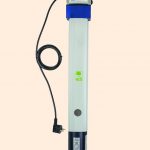Compressed air has become an indispensable medium in a wide range of processes. For three decades, Beko Technologies has been providing the industry with innovative technology for the treatment of compressed air and gases. In order to keep up with its growth in business, the compressed air specialist is currently extending its factory in Neuss, Germany. Also, its engineers recently came up with an electronically controlled drying system based on diaphragm technology, closing the gap between refrigeration and adsorption dryers.
Beko Technologies employs more than 450 people all over the world. With six production plants in Germany, India, China and the USA, plus an extensive network of sales offices, the company is one of the leading operators in the international market for compressed air and gas technology. This family-owned business has always been at the forefront of innovation. “While we still work primarily in the field of compressed air treatment, we are no longer just a supplier of products but operate as a systems and solutions provider”, explains Rainer Stützel, Corporate Identity & Relations Manager at Beko Technologies. With the recent launch of the Drypoint M eco control – an innovative, electronically controlled compressed air drying system – Beko has taken another step in the direction of Industry 4.0.
Although the last expansion of its premises in Neuss took place only six years ago, Beko Technologies is once more enlarging its facilities, and most of the work is already completed. The company is spending around 7 million euros on the new building. With more than 3850 m² of floor space, it will house new logistics and production areas as well as a number of offices, while the existing building will be converted into a technology centre. In addition, Beko Technologies is installing a combined heat and power plant to supply the entire company site. “This project will hopefully cater for our needs over the next seven to ten years”, says Stützel.
Ear to the ground
For Beko Technologies, “Better through Responsibility” is much more than just a slogan. At its own education centre, the company is continuously training its employees and investing in people. Beko Technologies employees on the ground know what is happening in the market and make sure that this information reaches the development team. The electronically controlled Drypoint M eco control drying system is just one example of a product that was developed in direct response to market demands. The initial idea came from Jan Slatmann, a sales representative at Beko Technologies Benelux. Dairy farmers in the region had told him about the problems they encountered with their milking robots, where the compressed air diaphragm dryer of a compressor constantly caused trouble. They blamed it on the ambient conditions, and especially on the dirt and moisture collecting inside their machines. To overcome these issues, Slatmann proposed replacing the diaphragm dryer with coated high-temperature refrigeration dryers, as this technology is better suited to deal with aggressive condensate. However, these units proved unsuitable for the cold winters, as low temperatures invariably led to condensation. It soon became obvious that refrigeration dryers were not the answer. Slatmann then suddenly had an idea: how about measuring the dew point temperature at the diaphragm dryer outlet and controlling the system based on this temperature? He subsequently spent many hours tinkering in his garage and eventually presented a home-made control system to the engineers at Beko Technologies. His invention worked so well that the development team used it as a template for a technical solution designed for large-scale applications.
Controlled drying
The Drypoint M eco control consists essentially of a diaphragm dryer with an integrated nano filter and a sensor unit that constantly measures the humidity and temperature in the compressed air flow. These values are then used to operate a solenoid valve that controls the purge air supply. When no compressed air is consumed, only measuring gas is fed through the sensor head. With this technology, it is possible to maintain a constant pressure dew point or pressure dew point difference irrespective of the actual ambient conditions and compressed air consumption. In addition, the system only consumes energy when in drying mode. The extremely compact Drypoint M eco control therefore combines low operating costs with short response times and closes the gap that exists between refrigeration and adsorption dryers. The purge air is controlled independently and the fail-safe function guarantees that the compressed air is always dried to the desired degree, even in the event of a power failure. In such a case, the purge air flow is automatically set to the highest level, so that the dew point does not rise, thus preventing condensation in the pipes.
Operators of compressed air systems generally use fixed pressure dew points as indicators for the degree of compressed air drying. The Drypoint M eco control makes use of this fact, as those operators can now set a pressure dew point between +10 and -25 °C depending on the application. In addition, they can choose between two operating modes and hence decide how the dryer should behave under changing operating conditions. In “constant” mode, a constant pressure dew point is maintained at the outlet.
In “dynamic” mode, the dryer is operated so that a preset difference is observed between the compressed air temperature and the pressure dew point at the outlet. In this mode, the pressure dew point is reduced relative to the compressed air temperature by a preset difference between 10 and 55 K. If the inlet temperature changes, the pressure dew point automatically follows suit. This guarantees consistent operating reliability, even for applications with a variable compressed air temperature.
The operating mode and the application-specific degree of drying can be selected quickly and easily on the user-friendly interface. The actual mode and status are clearly indicated by LEDs. Fault signals can be forwarded via a floating contact. An analogue interface for data transfer allows user-friendly performance monitoring and visualisation, for example by means of a Metpoint UD01 plug-on display or a Metpoint BDL data logger – another step towards Industry 4.0.
www.cpp-net.com search: cpp0117beko
Daniela Held
Editor, cpp chemical plants & processes
Share:









